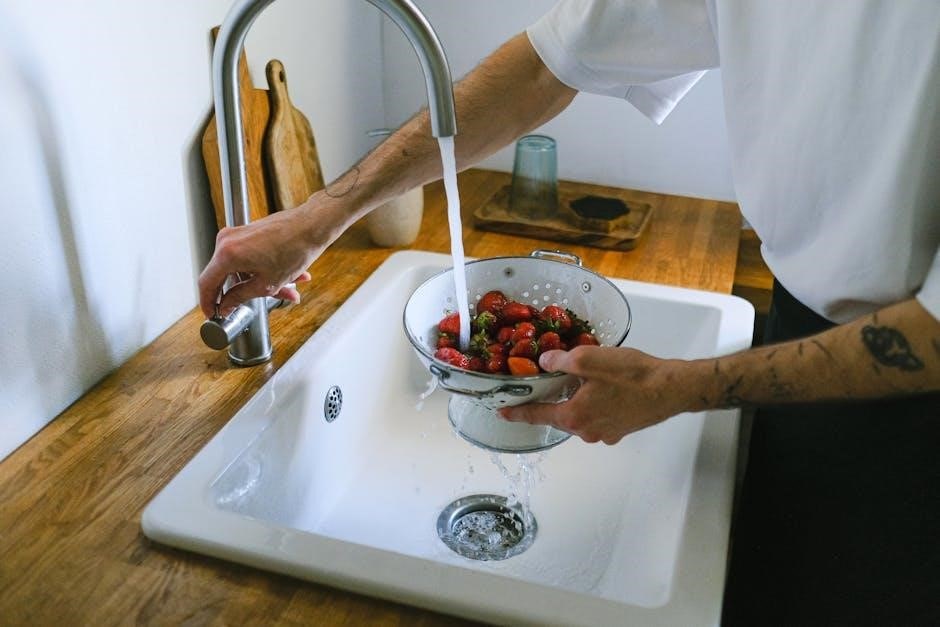
Proper care is essential to maintain the longevity and appearance of vinyl shirts․ Always wait 24 hours after application before washing to allow the vinyl to cure․ Turn shirts inside out to protect the design during washing․ Use cold water and a mild detergent to prevent damage․ Avoid bleach, fabric softeners, and dry cleaning․ Air drying is recommended, but tumble drying on low heat is acceptable․ Ironing should be done inside out on low heat if necessary․ Following these steps ensures your vinyl shirts remain vibrant and intact for years․

Pre-Wash Considerations
Allow the vinyl to cure for 24 hours after pressing to ensure proper adhesion․ This waiting period prevents peeling or residue during the first wash․
Letting the Vinyl Cure
Allowing the vinyl to cure is a critical step before washing․ After applying heat transfer vinyl (HTV), wait 24 to 48 hours for the adhesive to fully bond with the fabric․ This curing process ensures the vinyl adheres properly and prevents peeling or residue during the first wash․ Rushing this step can lead to poor adhesion and damage to the design․ The heat from the pressing process activates the adhesive, but it needs time to set completely․ During this period, avoid exposing the shirt to moisture or stress․ Once cured, the vinyl will be more durable and resistant to wear․ Proper curing is essential for maintaining the longevity and appearance of your vinyl shirt․ Always follow the recommended curing time before proceeding with any washing or drying steps․

Washing Instructions
Turn shirts inside out and wash in cold water with a mild detergent․ Avoid bleach and fabric softeners; Opt for a gentle cycle to protect the vinyl design․
Turning the Shirt Inside Out
Turning your vinyl shirt inside out before washing is a crucial step to protect the design․ This simple action reduces friction from other clothes and the washing machine’s agitator, preventing scratches or peeling․ By minimizing direct contact with abrasive forces, the vinyl graphic remains intact․ This method is widely recommended by crafting experts and ensures the longevity of your custom design․ Always prioritize this step to maintain the vibrant appearance and durability of your vinyl shirt․
Using Cold Water
Using cold water when washing vinyl shirts is essential to preserve the integrity of the design․ Cold water prevents the adhesive from weakening, which can lead to peeling or cracking of the vinyl․ Hot water can cause the vinyl to separate from the fabric or lose its vibrancy․ Additionally, cold water helps maintain the fabric’s shape and prevents shrinkage․ It is recommended to use a gentle cycle with cold water to ensure minimal agitation and stress on the vinyl graphic․ This method is universally advised by experts to maintain the durability and appearance of heat transfer vinyl designs․ Always opt for cold water to protect your vinyl shirt and extend its lifespan․
Choosing the Right Detergent
Choosing the right detergent is crucial when washing vinyl shirts to prevent damage to the design․ Opt for a mild detergent that is free from harsh chemicals, bleach, or fabric softeners, as these can weaken the vinyl’s adhesive and cause peeling or discoloration; Avoid using heavy-duty or abrasive detergents, as they may damage the vinyl or the fabric․ Liquid detergents are generally recommended over powder detergents, as they dissolve more easily and leave fewer residues․ For delicate or hand-wash cycles, a small amount of dish soap like Dawn, free from oils or moisturizers, can be used as an alternative․ Always avoid using bleach, as it can irreparably harm the vinyl․ Using the right detergent ensures the vinyl remains intact and vibrant, preserving the shirt’s appearance and longevity․

Drying Methods
Air drying is recommended to protect the vinyl design․ If using a dryer, tumble on low heat inside out to prevent damage․ Avoid high heat to preserve vinyl integrity․
Air Drying
Air drying is the most recommended method for preserving the quality of vinyl shirts․ After washing, gently remove excess water without wringing the fabric․ Lay the shirt flat or hang it inside out in a cool, well-ventilated area, away from direct sunlight․ Avoid folding or draping the shirt while it dries, as this can cause creases or stress on the vinyl․ Direct sunlight may cause fading or cracking of the vinyl design․ Air drying prevents exposure to high heat, which can weaken the adhesive and cause peeling․ This method ensures the vinyl remains intact and vibrant for a longer period․ For best results, allow the shirt to air dry completely before wearing or storing it․ Proper air drying is a simple yet effective way to maintain the durability and appearance of your vinyl shirt․
Tumble Drying on Low Heat
Tumble drying on low heat is an acceptable method for drying vinyl shirts, but it requires caution․ Always ensure the dryer is set to a low heat setting to prevent damage to the vinyl․ Remove the shirt as soon as the cycle ends to avoid wrinkles and stress on the vinyl․ High heat can weaken the adhesive, causing the vinyl to peel or crack․ If possible, use a clean, lint-free towel in the dryer to reduce friction․ Avoid using fabric softeners or bleach, as they can degrade the vinyl over time․ While air drying is preferable, tumble drying on low heat is a convenient alternative․ However, consistent use of high heat can reduce the lifespan of the vinyl design․ Always prioritize low heat and gentle cycles to maintain the quality of your vinyl shirt․

Avoiding Damage
Avoid dry cleaning, harsh chemicals, and high heat to prevent damaging the vinyl․ Ironing should be done inside out on low heat to avoid melting or cracking the design․
No Dry Cleaning
Dry cleaning is highly discouraged for vinyl shirts, as the harsh chemicals used in the process can damage the vinyl․ These solvents can weaken the adhesive, causing the vinyl to crack or peel away from the fabric․ The heat and pressure involved in dry cleaning further exacerbate the risk of damage, potentially ruining the design․ Instead of dry cleaning, opt for gentle hand washing or machine washing on a delicate cycle with cold water and mild detergent․ This approach ensures the vinyl remains intact and vibrant․ Avoiding dry cleaning is crucial to maintaining the longevity and appearance of your vinyl shirts․ Always check the care label for specific recommendations, as some vinyl types may require extra precautions to prevent deterioration․
Ironing Precautions
When ironing vinyl shirts, exercise extreme caution to avoid damaging the vinyl․ Always turn the shirt inside out and place a piece of cardboard or a heat-resistant material between the vinyl and the iron to protect the design․ Use a low heat setting and avoid applying direct heat to the vinyl, as high temperatures can cause it to melt, crack, or peel․ Never use steam, as it can weaken the adhesive bonding the vinyl to the fabric․ Ironing should only be done when absolutely necessary, and always follow the specific instructions provided with the vinyl product․ Proper precautions ensure the vinyl remains intact and maintains its vibrant appearance over time․
General Care Tips
Store vinyl shirts properly to maintain their appearance․ Avoid harsh chemicals and handle gently to prevent wear․ Regular care ensures the vinyl remains vibrant and intact over time․
Storing Properly
Proper storage is crucial to maintain the quality of your vinyl shirts․ Avoid exposing them to direct sunlight or heat sources, as this can cause the vinyl to fade or peel․ Fold the shirt carefully instead of hanging it, as hanging may stretch the fabric and loosen the vinyl over time․ Store the shirt in a cool, dry place, away from moisture to prevent mold or mildew․ Use a breathable material, like a cotton cloth, to cover the shirt if necessary․ Avoid stacking multiple vinyl shirts on top of each other, as the pressure may cause the vinyl to crack or peel․ By storing your vinyl shirts with care, you can ensure they remain in great condition for years to come․
Avoiding Harsh Chemicals
Avoiding harsh chemicals is vital to preserve the quality of your vinyl shirts․ Bleach, fabric softeners, and abrasive cleaners can damage the vinyl by weakening its adhesive or discoloring the design․ Instead, opt for mild detergents specifically designed for delicate fabrics․ When hand washing, a solution of 80% water and 20% liquid detergent is ideal․ For tougher stains, gently spot clean with a soft cloth and a small amount of mild soap․ Never use abrasive scrubbers or harsh solvents, as they can scratch or peel the vinyl․ Additionally, avoid using dish soap with oils or moisturizers, as they can leave residues that harm the vinyl․ By steering clear of harsh chemicals, you protect the vinyl and extend the life of your shirt․